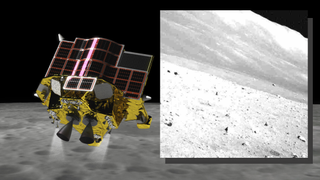
(Main) An illustration of the SLIM lunar lander approaching the moon (inset) An image of the lunar surface captured by the lander on April 23, 2024
(Image credit: JAXA)
The Smart Lander for Investigating Moon (SLIM) has survived its third week-long night on the moon.
This is despite the fact the Japanese lunar lander wasn’t designed to withstand even one blisteringly cold night on the moon, during which temperatures dropped as low as minus 274 degrees Fahrenheit (minus 170 degrees Celsius).
The Japan Aerospace Exploration Agency (JAXA) revealed that SLIM had braved its third lunar night on Wednesday (April 23) after receiving an image of the moon’s surface from the lander.
Related: It’s alive! JAXA’s SLIM moon lander sends home new photos after surviving frigid lunar night
On its X feed, JAXA shared an image captured by SLIM as it was coming out of its third lunar night spent on the moon.
In the translated tweet, the Japanese space agency wrote: “Last night (the night of April 23rd), we were able to successfully communicate with #SLIM, which had started up again, and confirmed that SLIM had survived for the third time.
“Here is a photo of the surface of the moon taken last night with the navigation camera. As this photo was taken at the earliest age of the moon so far after the overnight awakening, the moon is bright overall and the shadows are very short.”
昨晩(4/23 夜)、再び起動した #SLIM と通信することに成功し、SLIMが3回目の越夜を達成したことを確認しました。早速航法カメラにて撮影した昨晩の月面の様子がこちらです。越夜後としてはこれまでで最も早い月齢での撮影のため、全体的に明るく影が非常に短くなっています。 #JAXA #たのしむーん pic.twitter.com/U0f88xNK9SApril 24, 2024
SLIM arrived on the moon on Jan. 19, 2024, tasked with the mission of testing landing technology and collecting data about lunar geology. Soon after landing, its JAXA operators discovered that it had tipped forward, resting on its nose. This meant that its energy-gathering solar panels were not correctly orientated towards the sun, making its survival even more remarkable.
Breaking space news, the latest updates on rocket launches, skywatching events and more!
SLIM first night on the moon started on Jan. 31, ending on Feb. 15. Then night fell on SLIM again on Feb. 29, its operators had expected the repeated drop in temperature from around 212 degrees Fahrenheit (100 degrees Celcius) to around 274 degrees Fahrenheit (minus 170 degrees Celsius) to spell doom for the lander.
“Although the probability of failure will increase due to repeated severe temperature cycles, SLIM plans to try operations again the next time the sun shines (in late March),” JAXA said in an update.
When operations were then retried in mid-March, JAXA discovered that the main functions of the lander were still operational. And that seems to be the case again as SLIM emerged from lunar night again in mid-April, messaging home on April 23.
While SLIM was sending back images of the lunar surface, independent researcher in India Chandra Tungathurthi was using the Chandrayaan-2 orbiter to check up on the Japanese lunar lander. He shared some of the images he captured on his X feed.
Tungathurthi wrote: “I found SLIM using the Orbital high-resolution camera onboard Chandrayaan-2. The below picture was captured on 2024.03.16 at a pixel resolution of 16cm per pixel! Because of the low elevation of the sun, you see long-drawn shadows.”
🚨 I found @SLIM_JAXA using the Orbital high-resolution camera of @isro on board Chandrayaan-2. The below picture was captured on 2024.03.16 at a pixel resolution of 16cm per pixel! Because of the low elevation of the sun, you see long-drawn shadows. I’ve shared three… pic.twitter.com/9PIeAoFuVbApril 24, 2024
“I’ve shared three different views of the context of the location. I’ve already talked a lot about the location where SLIM landed earlier, you can see them below #SLIM woke up yesterday again for the third time – which is 3 consecutive nights it has done so,” he continued.
“SLIM has maintained its primary functions even after three overnight stays, which was not anticipated in its design,” JAXA said in a translated post on X. “We will continue to closely monitor SLIM’s condition and hope to identify areas that deteriorate depending on the lunar day and night environment, as well as areas that are not prone to deterioration.”
Join our Space Forums to keep talking space on the latest missions, night sky and more! And if you have a news tip, correction or comment, let us know at: community@space.com.
Robert Lea is a science journalist in the U.K. whose articles have been published in Physics World, New Scientist, Astronomy Magazine, All About Space, Newsweek and ZME Science. He also writes about science communication for Elsevier and the European Journal of Physics. Rob holds a bachelor of science degree in physics and astronomy from the U.K.’s Open University. Follow him on Twitter @sciencef1rst.
>>> Read full article>>>
Copyright for syndicated content belongs to the linked Source : Space.com – https://www.space.com/japan-slim-moon-lander-survives-3rd-lunar-night
